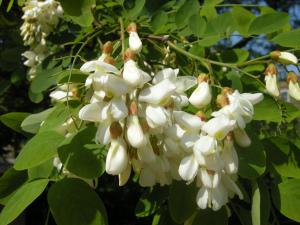
Robinia pseudoacacia flower (30/04/2011, London)
Position: Full sun.
Soil: Moist but well drained, will tolerate poor, dry soils
Flowering period: Mid summer
Eventual Height: 25m
Eventual Spread: 15m
Hardiness: USDA Zone 5a-9b
Family: Fabaceae
Robinia pseudoacacia is a deciduous tree with a broadly columnar habit. It has suckering, unusually spikey shoots and pinnate, dark green leaves composed of up to 23 lance shaped or ovate to elliptic, blunt leaflets. The inflorescence is in the form of very fragrant white flowers in long pendant racemes, which are followed by smooth, dark brown seedpods.
Robinia pseudoacacia, commonly known as the Black Locust Tree, the Locust tree and the False Acacia tree, is native to North America. It has historically been grown for firewood as it can tolerate almost any soil type, re-grows exceptionally quickly and gives wood that burns when wet. However due to natural predators it rarely reaches maturity and so cannot be grown on a commercial scale. It was introduced to Europe in 1601.
The etymological root of the binomial name Robinia is named after Jean Robin, a 17th century French botanist and herbalist to Henry IV and Louis XIII of France, and Vespasian Robin his son. Pseudoacaciais is derived from the Latin meaning ‘False Acacia’.

Robinia pseudoacacia (30/04/2011, London)
The landscape architect should not specify Robinia pseudoacacia in the UK as it has been added to Schedule 9 of the Wildlife and Countryside Act 1981 in 2005 It was a useful as a specimen tree, particularly for its open canopy which provides excellent dappled shade. A popular cultivar of this species is called R. pseudoacacia ‘Frisia’ which has bright golden-yellow leaves, these become vivid greenish-yellow in summer and orange-yellow in autumn.
Robinia pseudoacacia will tolerate almost any soil conditions; it will be happy in acid, neutral or alkaline pH levels, in loam, sand, clay or chalk and facing any aspect so long as it is given a sheltered location.
The use of Robinia pseudoacacia is apparently in decline due to a range of problems including the tree failing to come fully into leaf in spring, the dropping of foliage prematurely and brown spots appearing on the leaves. Although sometimes shoots often arise from the trunk and boughs as a result of these problems,generally the tree does not recover.
Ecologically, Robinia pseudoacacia will attract pollinating insects such as bees that will feed on its nectar.
The Royal Horticultural Society have given the cultivar Robinia pseudoacacia ‘Frisia’ their prestigious Award of Garden Merit.
Robinia pseudoacacia requires little maintenance. It can be cut back hard to the ground or pollarded, all pruning should be carried out in early autumn to prevent bleeding.

